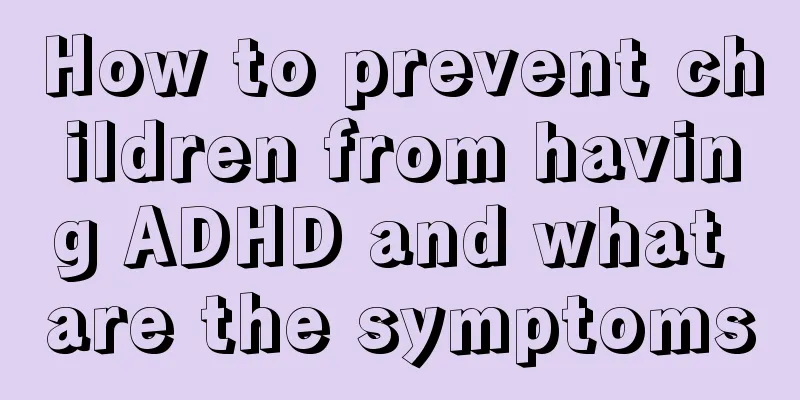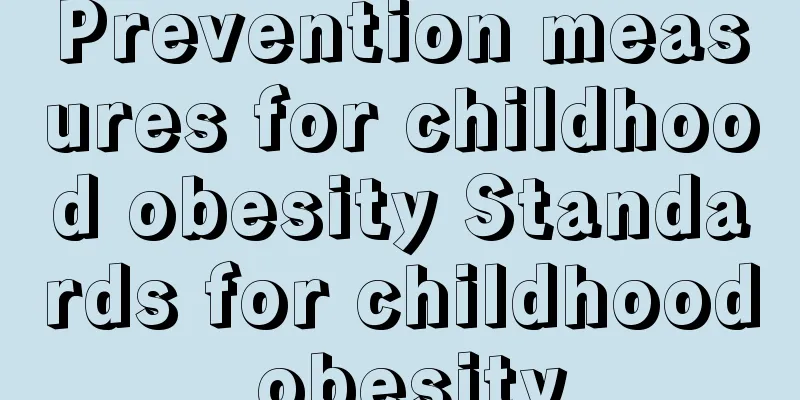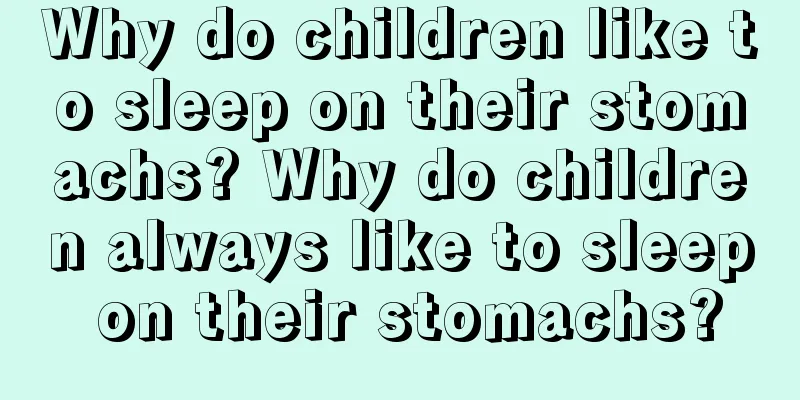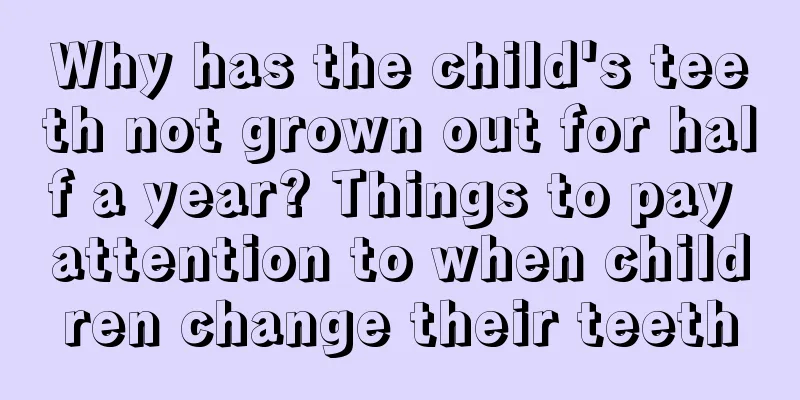How to prevent children from having ADHD and what are the symptoms

|
ADHD seriously affects children's physical and mental development and is not conducive to their overall development. So what is ADHD? What are the causes of ADHD? What are the symptoms of ADHD? How to treat ADHD? How to prevent ADHD? How to conduct psychological education for children with ADHD? What is good for children with ADHD? The following editor will introduce you in detail. What is ADHD in childrenAttention deficit hyperactivity disorder (ADHD) is a common psychological disorder in children. It is characterized by inattention and short attention span, hyperactivity and impulsivity that are not commensurate with age and development level, and is often accompanied by learning difficulties, conduct disorders and maladjustment. Some children still have symptoms after adulthood, which significantly affects their academic performance, physical and mental health, as well as their family life and social skills after adulthood. Causes of ADHD in Children1. Genetics. Family studies, twin studies, and foster child studies support that genetic factors are an important factor in the development of ADHD in children, with an average heritability of about 76%. 2. Neurotransmitters. Neurobiochemistry and psychopharmacology studies have found that there is an imbalance of neurochemical transmitters in the brain, such as low dopamine and norepinephrine function in the patient's blood and urine, and decreased 5-HT function. 3. Neuroanatomy and neurophysiology. Structural magnetic resonance imaging (MRI) found abnormal development of the frontal lobe and asymmetry of the bilateral caudate nucleus. Functional MRI also found that ADHD patients have brain function defects, such as hypofunction of the frontal lobe, and abnormal activation of the frontal lobe, especially the prefrontal lobe, basal ganglia, anterior cingulate cortex, cerebellum and other parts. 4. Environmental factors. These include prenatal, perinatal, and postnatal factors. Risk factors related to pregnancy and childbirth include smoking and drinking by mothers of ADHD patients, premature birth of children, hypoxic-ischemic encephalopathy after birth, and thyroid dysfunction. 5. Family and psychosocial factors. Parental discord, family breakdown, improper parenting, bad parental character, mother suffering from depression, father with impulsive, antisocial behavior or substance addiction, family financial difficulties, crowded housing, separation from parents in childhood, abuse, improper education methods in school, etc. are all possible causes of the disease or reasons for the persistence of symptoms. ADHD symptoms in children1. Attention deficit. The child obviously has difficulty concentrating for a long time, and the attention span is short. The child often has difficulty paying attention to classes, doing homework or other activities, and is easily distracted by external stimuli. The child cannot pay attention to details in learning or activities, and often makes mistakes due to carelessness. 2. Difficulty maintaining attention. Often intentionally avoiding and unwilling to engage in tasks that require long-term sustained concentration, such as classwork or homework. Procrastinating and unable to complete homework or assigned tasks on time. Patients are prone to forgetfulness and often lose toys and school supplies, forget daily activities, and even forget homework assigned by teachers. 3. Too much activity. The child often seems restless, moves a lot, has active hands and feet, and cannot stay still in his seat. He leaves his seat without permission in the classroom or other places where quietness is required, runs around or climbs around. It is difficult for him to engage in quiet activities or games, and he is busy all day long. 4. Impulsive behavior. Interrupting others when they are talking, and answering the teacher's questions before they are finished. Acting impulsively, not considering the consequences, and acting on a whim. Not waiting in line patiently. Reacting quickly without sufficient information. Often fighting or arguing with peers, resulting in adverse consequences. 5. Learning difficulties. Children with this disorder have poor listening ability in class and low speed and quality in completing homework, which results in poor academic performance, which is often lower than what they should achieve based on their intelligence. 6. Abnormal development of the nervous system. It is not easy to turn the hand, do finger movements, tie shoelaces and button, and it is difficult to distinguish left from right. The patient's fine movements, coordinated movements, spatial position sense, etc. are poorly developed. A small number of patients are accompanied by delayed language development, poor language expression ability, low intelligence and other problems. 7. Conduct disorder. The comorbidity rate of ADHD and conduct disorder is as high as 30%-58%. Conduct disorder is manifested as aggressive behavior, such as insulting, beating classmates, destroying property, abusing others and animals, sexual assault, robbery, etc., or some behaviors that do not conform to moral norms and social standards, such as lying, truancy, running away from home, arson, theft, etc. How to treat ADHD in children1. Psychological therapy. There are two main methods: behavioral therapy and cognitive behavioral therapy. The patient has poor peer relationships, aggressive language and behavior toward others, and poor self-control. Behavioral therapy uses the principle of operant conditioning to promptly give positive or negative reinforcement to the patient's behavior, so that the patient can learn appropriate social skills and replace inappropriate behavior patterns with new and effective behaviors. 2. Drug treatment. Drugs can improve attention deficit, reduce activity levels, improve academic performance to a certain extent, and improve the relationship between patients and family members in the short term. Central nervous system stimulants are generally used, and the first-line treatment drugs are mainly methylphenidate and its controlled-release tablets in China. Methylphenidate, low doses help improve attention, and high doses can improve hyperactivity and impulsive symptoms and reduce behavioral problems. 3. Behavior management and education. Teachers and parents need to conduct effective behavior management and psychological education based on the characteristics of the patient, avoid discrimination, corporal punishment or other rough educational methods, and appropriately use praise and encouragement to improve the patient's self-confidence and self-consciousness. The child's seat can be arranged near the teacher to reduce the child's distraction during class. When arranging courses, it is necessary to consider giving the patient sufficient time for activities. 4. Education and training for parents. Provide a good supportive environment for parents, so that they can learn the skills to solve family problems, learn to work with their children to develop clear reward and punishment agreements, effectively avoid contradictions and conflicts with their children, and master the correct use of positive reinforcement methods to encourage children's good behavior and use punishment methods to eliminate children's bad behavior. How to prevent ADHD in children1. Promote premarital examinations and avoid close relatives marrying. my country's Marriage Law clearly stipulates that close relatives within three generations are prohibited from marrying. Some examinations should be done before marriage, which can effectively avoid the occurrence of some diseases. 2. To avoid congenital deficiencies in children, you should get married at the right age and have good eugenics. Don't be too busy with your career and neglect your life. You will leave wealth to your children but not health. 3. Pregnant women should keep a happy mood. During pregnancy, pregnant women should pay attention to cultivating their temperament, keeping a happy mood, avoiding cold and heat, preventing diseases, using drugs with caution, and avoiding tobacco, alcohol and the influence of physical factors. 4. During childbirth, you should give birth naturally and avoid caesarean section to avoid harming the baby during the operation. Many expectant mothers are afraid of pain and choose caesarean section, which results in the occurrence of ADHD in their children and sows the seeds of badness. Among the many ADHD prevention measures, this one is the one that family members should pay special attention to. 5. Create a good family environment and a warm and harmonious living environment so that children can spend their childhood in a relaxed and happy environment. Teach students in accordance with their aptitude and do not blindly expect your children to become successful. 6. Eat a balanced diet and pay attention to nutritional combinations to help children develop good eating habits, avoid partial or picky eating habits, and ensure adequate sleep. Psychological education for children with ADHDChildren with ADHD are often withdrawn, willful, and have poor self-control. They also become mentally abnormal, weak-willed, and have volatile personalities. When treating children with ADHD, appropriate and patient psychological education is necessary to cooperate with treatment and achieve twice the result with half the effort. For some behaviors of children with ADHD, parents and teachers should give them opportunities to develop and demonstrate themselves, and encourage and affirm them. This will have a subtle effect on the psychological adjustment and behavioral transformation of children with ADHD. Be caring and considerate to children with ADHD. Do not be disgusted by their hyperactivity. Reach an agreement with teachers on education and discover more of their strengths. If children do not observe discipline in class, assign them to work as class leaders and discipline them. Children with ADHD are often too excited to rest according to a normal schedule. At this time, on the premise of satisfying the child's activity needs, we should train the child to have a good life routine and urge him to abide by the routine. Parents and teachers should overcome their rude, cold and discriminatory attitudes towards children with the disease, cooperate with each other, and educate them patiently and in a planned manner. What to eat for children with ADHD1. Eat less food containing tyrosine, such as noodles, cakes, etc.; eat less food containing methylsalicylic acid, such as tomatoes, apples, oranges, etc.; do not add spicy condiments such as pepper to the diet, and do not use tartaric acid, such as shellfish, red apples, olives and other foods. 2. Eat more foods rich in zinc. Zinc is a trace element in the human body and is closely related to human growth and development. Zinc deficiency often causes children to have poor appetite, slow development, and reduced intelligence. Studies have found that most students with excellent academic performance have higher zinc content in their hair. Therefore, eating foods rich in zinc, such as eggs, liver, beans, peanuts, etc., is helpful in improving intelligence. 3. Eat more iron-rich foods. Because iron is the raw material for blood production, iron deficiency can cause brain dysfunction, affect children's emotions, and aggravate ADHD symptoms. Therefore, children with ADHD should eat more iron-rich foods, such as liver, poultry blood, lean meat, etc. 4. Eat less lead-containing foods. Because lead can change children's visual movement, memory perception, image thinking, behavior, etc., and cause hyperactivity, children with ADHD should eat less lead-containing preserved eggs, shellfish and other foods. 5. Eat less aluminum-containing foods. Aluminum is a metal that threatens human health. Excessive aluminum intake can lead to intellectual impairment, memory loss, loss of appetite, and indigestion. Children with ADHD should eat less fried dough sticks, because alum needs to be added to the flour to make fried dough sticks, and the chemical composition of alum is potassium aluminum sulfate. Therefore, eating fried dough sticks is not good for children's intellectual development. |
>>: Does Crest toothpaste contain fluoride? Is Crest toothpaste good?
Recommend
Can children with anemia eat donkey-hide gelatin? How to choose milk powder for children with anemia
Anemia in young children is a common phenomenon n...
What causes baby eczema? How to take care of baby eczema and make it heal quickly?
Since babies are born not long ago, they will hav...
Does the child snore because he is sleeping soundly? What is the reason for the child snoring?
Sometimes children snore, and parents just think ...
Is Caesarean section really that safe? What are the risks?
Giving birth is the most difficult moment in a wo...
Can babies eat yellow peaches? How can babies eat yellow peaches better?
Yellow peach is a very common fruit in our daily ...
Should you squeeze the nipple of a newborn baby?
The whole family is very happy when the baby is b...
Are pregnancy test strips accurate? How to read pregnancy test strips? Please give me a diagram
Pregnancy test strips are cheap and easy to test,...
Do electric toothbrushes damage gums? Do electric toothbrushes damage tooth enamel?
Electric toothbrushes can also be used by the eld...
Can I drink coffee during pregnancy? Does drinking coffee have any effect on pregnancy?
Women are very vulnerable when preparing for preg...
Why do babies not sleep at night? How to care for babies?
New parents deeply understand how difficult it is...
Do newborn babies need pillows? Do newborns need pillows to shape them?
Many mothers say that when babies sleep, their he...
Can pregnant women eat turkey noodles? Can pregnant women eat turkey noodles?
I believe that many friends who love noodles have...
How is Junlebao milk powder? Which series of Junlebao milk powder is good?
As we all know, there are many brands of milk pow...
How to cultivate good hygiene habits in children
Children need to learn a lot of different knowled...
The reason why babies don't cry when they are held in an airplane position. How many months can they be held in an airplane position?
Babies sometimes cry for no apparent reason, and ...









